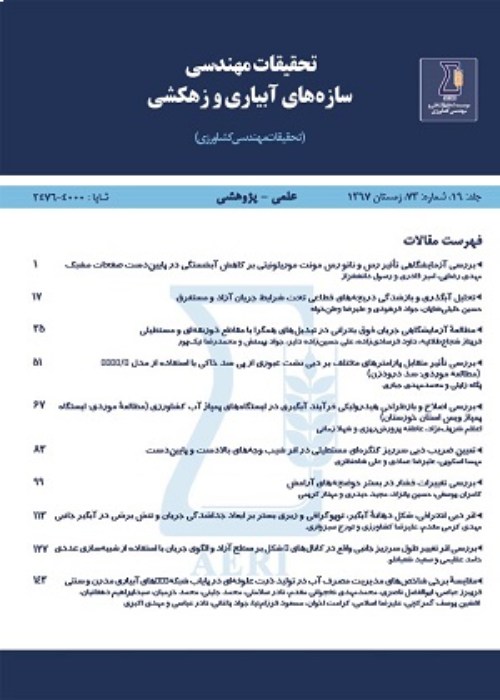Development of Water, Energy and Food Nexus Model in Irrigation Networks Based on Water Adequacy and Stability Indicators (Qazvin Irrigation Network Case Study)
Water, food and energy are the main resources needed for the development of societies. Recently, comprehensive management from Nexus' point of view has been examined and evaluated by focusing on these three sources at the macro, regional and basin levels. However Nexus approach has received less attention in irrigation networks, which consumes energy, and the most water, and produce the most food. (Mabhaudhi et al., 2018). International Commission of Irrigation and Drainage (ICID) announced the Nexus as one of the main topics for 2017 and 2018 congress. Some papers were presented with the focus on food security, energy consumption for ground water extraction, and climate change. As conclusion of both congress it is stated that even though the nexus approach is fast growing, however its application is very limited. Therefore Nexus knowledge and capacity building among stakeholders should be developed, and its application in development planning of irrigation networks should be considered (Hassan, et al. 2017 & Pandya, et al. 2018). Relationships of water, food, and energy at irrigation networks, due to the problems of each component, and their interactions are quite complex. In this study systems dynamics approach used to investigate existing structures between these sources, and causal relationship between different components is determined as a conceptual model. Subsequently, by development of quantified model, the Nexus model of Qazvin Irrigation Network from productivity, adequacy and sustainability of water delivery has been produced. Three scenarios regarding water, food and energy, including, reducing surface water resources, increasing cultivated area, and increasing energy consumption, were evaluated. System Dynamic approach enables us to consider the complex interactions between water, food and energy components in long term in irrigation networks, and examined the impact of different scenarios, to decide on more sustainable policies. In this approach by problem definition, and determination of the boundaries of the system, the dynamics of the system in form of casual loops are defined. Four archetypes are identified which are Limits to Growth, Shifting the Burden, Fixes that Fail, and Eroding Goals. Considering casual loops in water, food, and energy systems, the conceptual model of the Nexus in irrigation networks is developed. By collecting the required data from Ghazvin irrigation network the quantitative model is developed and verified using VENSIM model. The quantitative model is developed by defining mathematical relations between different components. The equations are defined in four subsystems including water demand and supply, food production, productivity, and water utility. In these relations, different information such as ground water extraction, surface water supply, required agricultural inputs, etc. are defined based on collected data in form of 10 year time series. Model verification is done by behavior investigation and boundary value test. The model estimated crop production, show good consistency with actual data with average error of 0.1%, and boundary value test show expected results. Therefore the verification results show appropriate performance of the model. Three scenarios for each resources (water, Food, and Energy) were examined which include, increasing energy consumption for ground water extraction, increasing cultivated area, and decreasing surface water.Testing three scenarios provide the following
Continuation of the present condition, will led to increase of crop production up to 60% in early 10 years. However due to activation of controlling mechanisms it sharply decreases by 50% in 5 years. Water utility shows similar manner, initially 20% increase, and 10% decrease afterward. Increasing energy consumption and ground water extraction causes crop production increase in almost all the simulation period with lower variations. Four years delay in impact of controlling mechanism is visible. Water utility has been increased as well, and it is 7% more at the end of simulation period. Due to limited potentials of increasing cropped area, this scenario performs similar to continuation of present condition, with marginal improvement in crop production and water utility. Decreasing surface water has the greatest impact in decreasing crop production and water utility, with respect to continuation of present condition. The maximum decrease in crop production and water utility are 23%, and 32% respectively. Even though due to activation of balancing mechanisms crop production shows 60% increase, however it happens with 5 year delay and decreases sharply afterward. Considering limited water resources, and its greatest impact on crop production and water utility, it could be suggested that water management policies, take higher priority in Nexus approach. As a general conclusion it could be stated that, system dynamic is a suitable method to implement Nexus approach in irrigation networks, and to investigate the long term impact of different scenarios, to select more sustainable policies for irrigation development.
- حق عضویت دریافتی صرف حمایت از نشریات عضو و نگهداری، تکمیل و توسعه مگیران میشود.
- پرداخت حق اشتراک و دانلود مقالات اجازه بازنشر آن در سایر رسانههای چاپی و دیجیتال را به کاربر نمیدهد.



